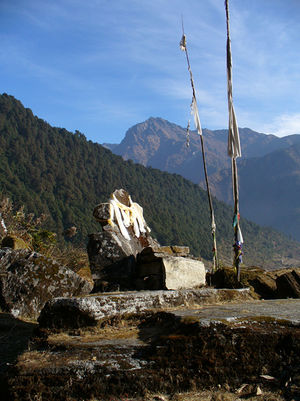Shugtri: Difference between revisions
Jump to navigation
Jump to search
SherabDrime (talk | contribs) No edit summary |
SherabDrime (talk | contribs) mNo edit summary |
||
| Line 1: | Line 1: | ||
[[Image:ShugTri.jpg|thumb|The self-arisen throne of Guru Padmasambhava, Melamchigaon]] | [[Image:ShugTri.jpg|thumb|The self-arisen throne of Guru Padmasambhava, Melamchigaon]] | ||
A self-arisen stone-throne of [[Guru Padmasambhava]] near the village of Milamkhyim (Melamchigaon) in [[Yolmo]]. It is considered one of the most sacred places in all of [[Yolmo]]. It is surrounded by many miraculously formed rocks of different shapes, such as a self-arisen stupa above the throne, seven perfectly shaped stones protruding from a sheer rock-face known as the "Seven Offering-bowls" (a difficult climb and impossible to photograph) and the clear design of a snake on the same rock-face, said to be a naga that was defeated there by Guru Rinpoche in magical combat. [TSD] | A self-arisen stone-throne of [[Guru Padmasambhava]] near the village of Milamkhyim (Melamchigaon) in [[Yolmo]]. It is considered one of the most sacred places in all of [[Yolmo]]. It is surrounded by many miraculously formed rocks of different shapes, such as a self-arisen stupa above the throne, seven perfectly shaped stones protruding from a sheer rock-face known as the "Seven Offering-bowls" (a difficult climb and impossible to photograph, unless you have a third hand to hold on for dear life while operating the camera with the other two) and the clear design of a snake on the same rock-face, said to be a naga that was defeated there by Guru Rinpoche in magical combat. [TSD] | ||
[[Category:Sacred Sites]] | [[Category:Sacred Sites]] | ||
[[Category:Nepal]] | [[Category:Nepal]] | ||
Latest revision as of 03:45, 22 January 2014
A self-arisen stone-throne of Guru Padmasambhava near the village of Milamkhyim (Melamchigaon) in Yolmo. It is considered one of the most sacred places in all of Yolmo. It is surrounded by many miraculously formed rocks of different shapes, such as a self-arisen stupa above the throne, seven perfectly shaped stones protruding from a sheer rock-face known as the "Seven Offering-bowls" (a difficult climb and impossible to photograph, unless you have a third hand to hold on for dear life while operating the camera with the other two) and the clear design of a snake on the same rock-face, said to be a naga that was defeated there by Guru Rinpoche in magical combat. [TSD]
